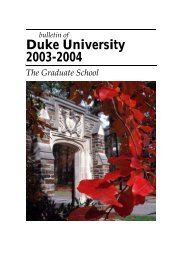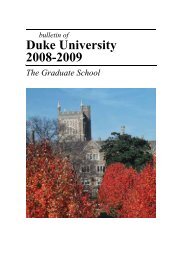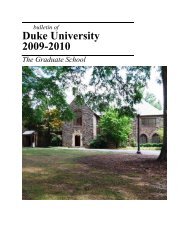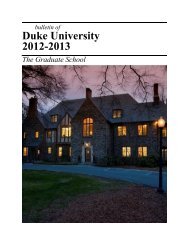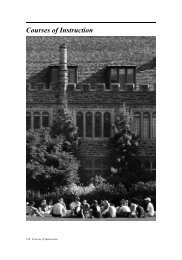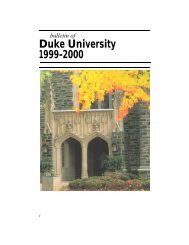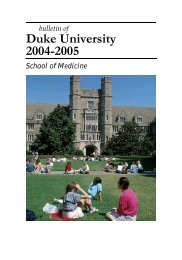2005-06 - Office of the Registrar - Duke University
2005-06 - Office of the Registrar - Duke University
2005-06 - Office of the Registrar - Duke University
Create successful ePaper yourself
Turn your PDF publications into a flip-book with our unique Google optimized e-Paper software.
223. Cellular and Integrative Cardiovascular Physiology and Biophysics<br />
232L. Biomedical Instrumentation<br />
244. Ma<strong>the</strong>matical Models <strong>of</strong> Physiological Systems<br />
250. Cardiovascular Mechanics<br />
Civil and Environmental Engineering (CE)<br />
Pr<strong>of</strong>essor Avissar, Chair (121 Engineering); Associate Pr<strong>of</strong>essor Kabala, Director <strong>of</strong><br />
Graduate Studies; Pr<strong>of</strong>essors Barros, Haff, Katul, Laursen, Malin, Medina, Petroski, and<br />
Virgin; Associate Pr<strong>of</strong>essors Albertson, Boadu, Gavin, Hueckel, Kasibhatla, Peirce, and<br />
Porporato; Assistant Pr<strong>of</strong>essors Dolbow, Khlystov, Linden, Nadeau, and Schuler; Assistant<br />
Research Pr<strong>of</strong>essors Ormeci and Sharpless; Pr<strong>of</strong>essor Emeriti Wilson<br />
The Department <strong>of</strong> Civil and Environmental Engineering (CEE) at <strong>Duke</strong> <strong>University</strong><br />
<strong>of</strong>fers programs <strong>of</strong> study and research leading to <strong>the</strong> M.S. and Ph.D. degrees with a major<br />
in Civil and Environmental Engineering. Students may specialize in one <strong>of</strong> <strong>the</strong> following<br />
tracks: (1) materials, structures and geo-systems; (2) hydrology and environmental fluid<br />
dynamics; and (3) pollution and remediation.<br />
Current research in <strong>the</strong>se areas focuses on: new computational paradigms for complex<br />
mechanical systems, including contact, fracture and damage problems; environmental<br />
geomechanics and geophysics; adaptive materials and structures and <strong>the</strong>ir use in structural<br />
dynamics; microstructred materials; deterministic and stochastic water resources and<br />
contaminant hydrology; global and regional water cycle; ocean-land-atmosphere<br />
interactions; biological and chemical aspects <strong>of</strong> pollution and its remediation in water, air<br />
and soil.<br />
Additionally, students may explore interdisciplinary research topics within a new<br />
strategic initiative undertaken by CEE in <strong>the</strong> area <strong>of</strong> “Extreme Environments.” Research in<br />
this field will ensure a safer response <strong>of</strong> <strong>the</strong> environment and structures to various extreme<br />
conditions, occurring spontaneously, incidentally or by design. The Department also<br />
supports two new multi-disciplinary research thrusts in (1) instrument and sensor<br />
technology applied to measurements in and monitoring <strong>of</strong> environmental, structural and<br />
geo-environmental systems and (2) ma<strong>the</strong>matical and experimental simulators, all broadly<br />
related to <strong>the</strong> natural and engineered environments. With <strong>the</strong> latter initiatives <strong>the</strong> Department<br />
plans to lead <strong>the</strong> pr<strong>of</strong>ession in developing a new physical models aimed at simulating <strong>the</strong><br />
chemical, biological, physical, and mechanical aspects <strong>of</strong> <strong>the</strong> environment and structures.<br />
That includes scaling laws to extrapolate processes from <strong>the</strong> model scale to <strong>the</strong> local,<br />
regional and global scales, or from <strong>the</strong> micro-structural to macro-structural scale. These new<br />
physical models will also provide a means <strong>of</strong> studying <strong>the</strong> fundamental processes necessary<br />
to develop self-sustained environmental systems to be used for long-term space exploration<br />
missions.<br />
200. Engineering Data Analysis. Introduction to <strong>the</strong> statistical error analysis <strong>of</strong> imprecise<br />
data and <strong>the</strong> estimation <strong>of</strong> physical parameters from data with uncertainity. Interpolation and<br />
filtering. Data and parameter covariance. Emphasis on time series analysis in <strong>the</strong> time- and<br />
frequency-domains. Linear and nonlinear least squares. Confidence intervals and belts.<br />
Hypo<strong>the</strong>sis testing. Introduction to parameter estimation in linear and nonlinear dynamic<br />
systems. Prerequisite: graduate standing or instructor consent. Instructors: Gavin or Boadu.<br />
3 units.<br />
201. Continuum Mechanics. Tensor fields and index notation. Analysis <strong>of</strong> states <strong>of</strong> stress<br />
and strain. Conservation laws and field equations. Constitutive equations for elastic,<br />
viscoelastic, and elastic-plastic solids. Formulation and solution <strong>of</strong> simple problems in<br />
elasticity, viscoelasticity, and plasticity. Instructors: Hueckel, Laursen, or Nadeau. 3 units.<br />
202. Applied Ma<strong>the</strong>matics for Engineers. Advanced analytical methods <strong>of</strong> applied<br />
ma<strong>the</strong>matics useful in solving a wide spectrum <strong>of</strong> engineering problems. Applications <strong>of</strong><br />
linear algebra, calculus <strong>of</strong> variations, <strong>the</strong> Frobenius method, ordinary differential equations,<br />
partial differential equations, and boundary value problems. Prerequisites: Math 108 or<br />
Civil and Environmental Engineering (CE) 133



